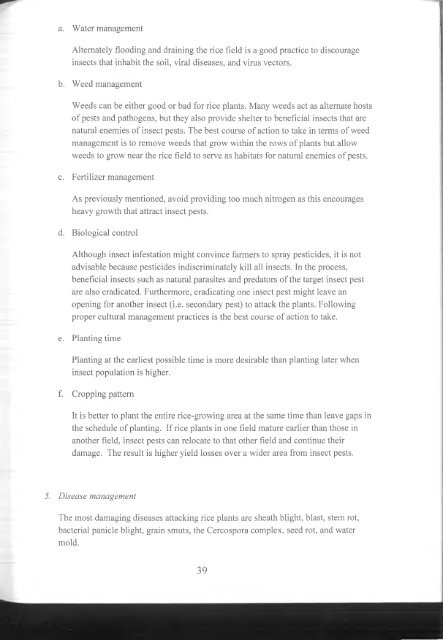Bradbrook - 2012 - Rice Farming complete with methods to increase ric
Bradbrook - 2012 - Rice Farming complete with methods to increase ric
Bradbrook - 2012 - Rice Farming complete with methods to increase ric
You also want an ePaper? Increase the reach of your titles
YUMPU automatically turns print PDFs into web optimized ePapers that Google loves.
a. Water management<br />
Alternately flooding and draining the riee field is a good practice <strong>to</strong> discourage<br />
insects that inhabit the soil, viral diseases, and virus vec<strong>to</strong>rs.<br />
b. Weed management<br />
Weeds can be either good or bad for <strong>ric</strong>e plants. Many weeds act as alternate hosts<br />
of pests and pathogens, but they also provide shelter <strong>to</strong> beneficial insects that are<br />
natural enemies of insect pests. The best course of action <strong>to</strong> take in terms of weed<br />
management is <strong>to</strong> remove weeds that grow <strong>with</strong>in the rows of plants but allow<br />
weeds <strong>to</strong> grow near the <strong>ric</strong>e field <strong>to</strong> serve as habitats for natural enemies of pests.<br />
c. Fertilizer management<br />
As previously mentioned, avoid providing <strong>to</strong>o much nitrogen as this encourages<br />
heavy growth that attract insect pests.<br />
d. Biological control<br />
Although insect infestation might convince farmers <strong>to</strong> spray pesticides, it is not<br />
advisable because pesticides indiscriminately kill all insects. In the process,<br />
beneficial insects such as natural parasites and preda<strong>to</strong>rs of the target insect pest<br />
are also eradicated. Furthermore, eradicating one insect pest might leave an<br />
opening for another insect (i.e. secondary pest) <strong>to</strong> attack the plants. Following<br />
proper cultural management practices is the best course of action <strong>to</strong> take.<br />
e. Planting time<br />
Planting at the earliest possible time is more desirable than planting later when<br />
insect population is higher.<br />
f. Cropping pattern<br />
It is better <strong>to</strong> plant the entire <strong>ric</strong>e-growing area at the same time than leave gaps in<br />
the schedule of planting. If <strong>ric</strong>e plants in one field mature earlier than those in<br />
another field, insect pests can relocate <strong>to</strong> that other field and continue their<br />
damage. The result is higher yield losses over a wider area from insect pests.<br />
5. Disease management<br />
The most damaging diseases attacking <strong>ric</strong>e plants are sheath blight, blast, stem rot,<br />
bacterial panicle blight, grain smuts, the Cercospora complex, seed rot, and water<br />
mold.<br />
39

















